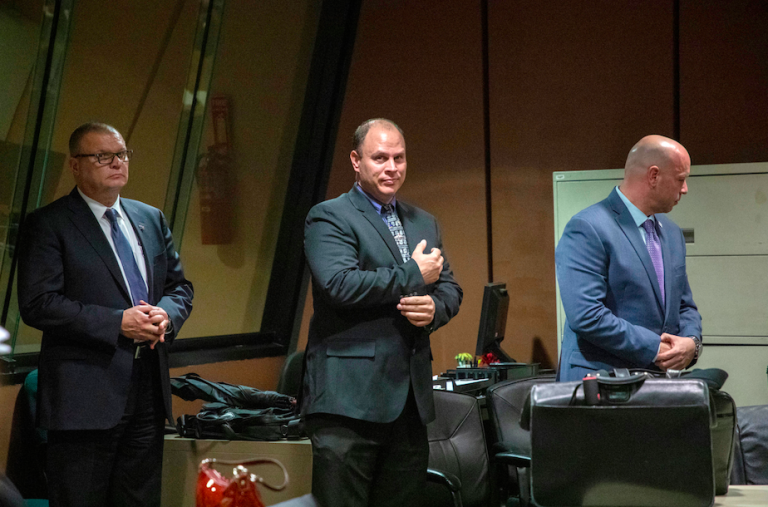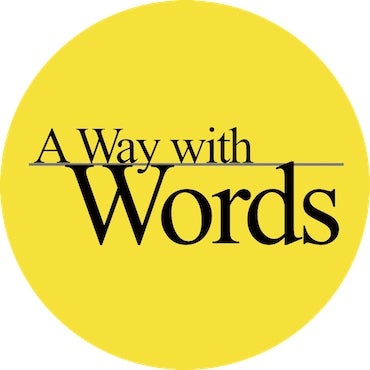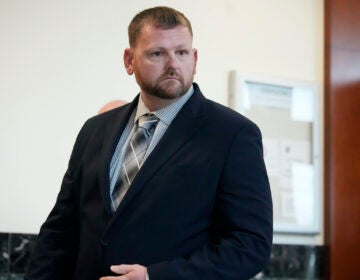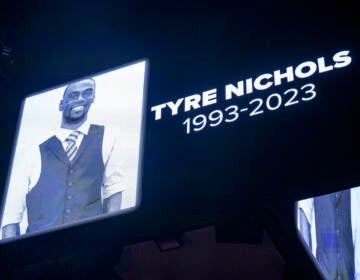Judge acquits 3 Chicago officers of Laquan McDonald cover-up
A judge on Thursday acquitted three Chicago police officers of trying to cover up the 2014 police shooting of black teenager Laquan McDonald to try to protect another officer.

In this Oct. 30, 2018 file photo, from left, former Detective David March, Chicago Police Officer Thomas Gaffney and former officer Joseph Walsh appear at a pre-trial hearing in Chicago. The three Chicago police officers are accused of participating in a cover-up of the fatal shooting of Laquan McDonald (Zbigniew Bzdak/Chicago Tribune via AP)
A judge on Thursday acquitted three Chicago police officers of trying to cover up the 2014 police shooting of black teenager Laquan McDonald to try to protect another officer who pulled the trigger.
After a trial that was watched closely by law enforcement and critics of the department that has long had a reputation for condoning police brutality and misconduct, Cook County Judge Domenica Stephenson acquitted former Officer Joseph Walsh, former Detective David March and Officer Thomas Gaffney on charges of conspiracy, official misconduct and obstruction of justice.
The judge said there was no evidence that officers tried to hide or bury evidence. “The evidence shows just the opposite,” she said. She singled out how they had preserved the police dashcam video at the heart of the evidence that convicted Officer Jason Van Dyke, who shot McDonald 16 times.
Van Dyke was convicted in October of second-degree murder and aggravated battery and is due to be sentenced Friday.
Both trials hinged on the dashcam video, which shows Van Dyke shoot McDonald within seconds of getting out of his police SUV and then continue shooting the 17-year-old while he was lying on the street and barely moving. Police were responding to a report of a male who was breaking into trucks and stealing radios on the city’s South Side.
Prosecutors allege that Gaffney, March and Walsh, who was Van Dyke’s partner, submitted false reports about what really happened to try to prevent or shape any criminal investigation of the shooting. Among other things, they say the officers falsely claimed that McDonald ignored verbal commands from Van Dyke, that Van Dyke shot McDonald after McDonald aggressively swung a knife at the officers and that he kept shooting the teen because McDonald was trying to get up still armed with the knife.
McDonald did have a small knife that he had used to puncture a tire on Gaffney’s police vehicle, but the video shows that he didn’t swing it at the officers before Van Dyke shot him and that he appeared to be incapacitated after falling to the ground.
“The case is clear, the case is straightforward, and it is concise,” Special Prosecutor Patricia Brown Holmes told the judge during her opening statements. “It boils down to what the defendants wrote on paper versus what is shown on video.”
When later summarizing her case, Holmes urged Stephenson to hold the officers accountable and to provide some measure of justice to the slain teen.
“Laquan McDonald was a human being. He deserved due process in the law and not to have police officers write false reports and shape a false narrative,” Holmes said.
The attorneys for Gaffney, Walsh and March — the latter two of whom have since left the police force — used the same strategy that the defense used at Van Dyke’s trial by placing all the blame on McDonald.
It was McDonald’s refusal to drop his knife and threatening actions that “caused these officers to see what they saw,” March’s attorney, James McKay, told the court. “This is a case about law and order (and) about Laquan McDonald not following any laws that night.”
The lawyers ridiculed the decision to charge the three officers, saying they merely wrote what they observed or, in March’s case, what the other officers told him they saw. And they said there was no evidence that the officers conspired to get their stories straight.
“The state wants you to criminalize police reports,” McKay bellowed at one point.
The McDonald shooting sparked large protests and led to major changes to Chicago’s policing, but only more than a year after the fact. City Hall only released the video to the public in November 2015 — 13 months after the shooting — because a judge ordered it to do so. The charges against Van Dyke weren’t announced until the day of the video’s release.
The case cost the police superintendent his job and was widely seen as the reason the county’s top prosecutor was voted out of office a few months later. It was also stunning because it led to charges not only against Van Dyke, but against the three officers accused of covering for each other as part of a “code of silence” that until recent years city officials adamantly denied even existed.
At the same time, the case prompted a federal investigation that resulted in a blistering report that found Chicago officers routinely used excessive force and violated the rights of residents, particularly minorities. The city implemented a new policy that requires video of fatal police shootings to be released within 60 days, accelerated a program to equip all officers with body cameras, and implemented a host of reforms to change the way officers are trained and investigate officer-involved shootings.
WHYY is your source for fact-based, in-depth journalism and information. As a nonprofit organization, we rely on financial support from readers like you. Please give today.



